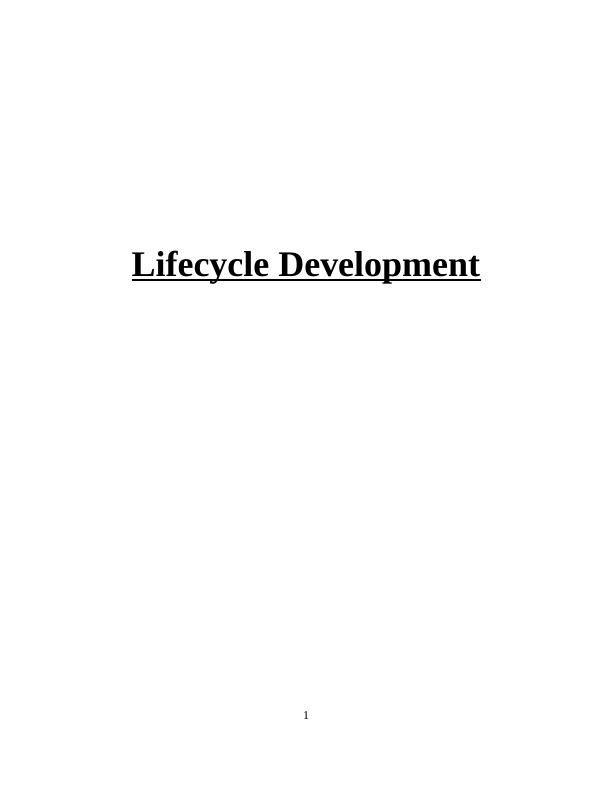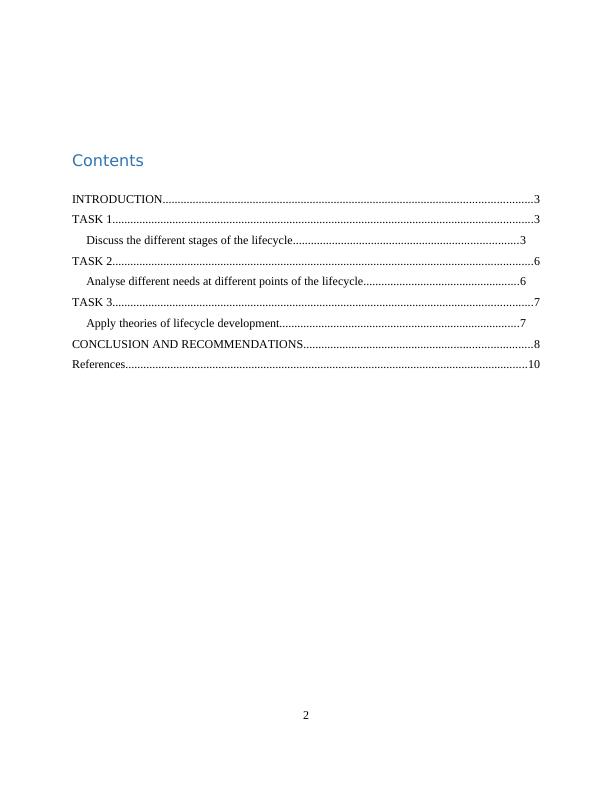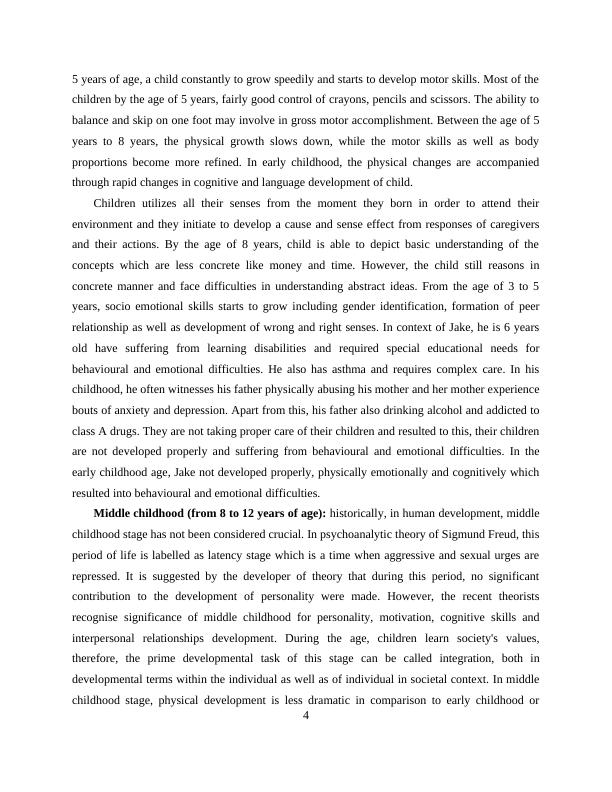Lifecycle Development
Added on 2023-01-06
11 Pages3764 Words52 Views
Lifecycle Development
1
1

Contents
INTRODUCTION...........................................................................................................................3
TASK 1............................................................................................................................................3
Discuss the different stages of the lifecycle...........................................................................3
TASK 2............................................................................................................................................6
Analyse different needs at different points of the lifecycle....................................................6
TASK 3............................................................................................................................................7
Apply theories of lifecycle development................................................................................7
CONCLUSION AND RECOMMENDATIONS............................................................................8
References......................................................................................................................................10
2
INTRODUCTION...........................................................................................................................3
TASK 1............................................................................................................................................3
Discuss the different stages of the lifecycle...........................................................................3
TASK 2............................................................................................................................................6
Analyse different needs at different points of the lifecycle....................................................6
TASK 3............................................................................................................................................7
Apply theories of lifecycle development................................................................................7
CONCLUSION AND RECOMMENDATIONS............................................................................8
References......................................................................................................................................10
2

INTRODUCTION
Over the time, human body change significantly and the food is serve as a fuel for those
changes. Throughout the life cycle of a human, changes take place in the body constantly and
goes through distinct periods called as stages. These stages include early childhood, middle
childhood, adolescence, late adolescence, middle age and old age. During each stage, various
changes takes place in terms of physical, cognitive, social and emotional development. This
report is based on a case study of Harry and Jake Morgan who was suffering from learning
disabilities as well as have special educational needs for behavioural and emotional difficulties.
The children are at the risk of harm and requires appropriate care and support. This report intent
to develop a strategy requires to understand the needs of Jake and his family as well as assist
them to move forward. This report covers different stages of life cycle in context Jake along with
analysing the different needs at different points of life cycle. Apart from this, the theories of life
cycle development are included and applied to the life cycle of Jake. At last, appropriate
recommendations are provided along with the brief conclusion in this report.
TASK 1
Discuss the different stages of the lifecycle
There are three broad development stages including early childhood, middle childhood as
well as adolescence. Each of the stage, a child develops socially, physically, emotionally and
cognitively along with environmental and social cultural influences experiences. Each stage of
life cycle development in context of Jake are discussed below:
Early childhood (from birth to eight years of age): it is a tremendous growth time across
all the development areas. In this stage, a dependent infant grows into young individual who can
be able to take care of own self as well as able to interact with others. Due to this reason, the
prime developmental activity in this stage of development of skills. Physically, from the birth to
three years of age, a child quadruples in weight and doubles in height. The bodily proportions are
also shift as the head of an infant which account for almost one fourth of total length of the body,
becomes a toddler, an adult like appearance with more balanced. Apart from this physical
changes, 3-year-old child has mastered in skills like walking, scribbling, sitting, toilet training,
sufficient hand-eye coordination to throw and catch a ball and using a spoon. Between 3 years to
3
Over the time, human body change significantly and the food is serve as a fuel for those
changes. Throughout the life cycle of a human, changes take place in the body constantly and
goes through distinct periods called as stages. These stages include early childhood, middle
childhood, adolescence, late adolescence, middle age and old age. During each stage, various
changes takes place in terms of physical, cognitive, social and emotional development. This
report is based on a case study of Harry and Jake Morgan who was suffering from learning
disabilities as well as have special educational needs for behavioural and emotional difficulties.
The children are at the risk of harm and requires appropriate care and support. This report intent
to develop a strategy requires to understand the needs of Jake and his family as well as assist
them to move forward. This report covers different stages of life cycle in context Jake along with
analysing the different needs at different points of life cycle. Apart from this, the theories of life
cycle development are included and applied to the life cycle of Jake. At last, appropriate
recommendations are provided along with the brief conclusion in this report.
TASK 1
Discuss the different stages of the lifecycle
There are three broad development stages including early childhood, middle childhood as
well as adolescence. Each of the stage, a child develops socially, physically, emotionally and
cognitively along with environmental and social cultural influences experiences. Each stage of
life cycle development in context of Jake are discussed below:
Early childhood (from birth to eight years of age): it is a tremendous growth time across
all the development areas. In this stage, a dependent infant grows into young individual who can
be able to take care of own self as well as able to interact with others. Due to this reason, the
prime developmental activity in this stage of development of skills. Physically, from the birth to
three years of age, a child quadruples in weight and doubles in height. The bodily proportions are
also shift as the head of an infant which account for almost one fourth of total length of the body,
becomes a toddler, an adult like appearance with more balanced. Apart from this physical
changes, 3-year-old child has mastered in skills like walking, scribbling, sitting, toilet training,
sufficient hand-eye coordination to throw and catch a ball and using a spoon. Between 3 years to
3

5 years of age, a child constantly to grow speedily and starts to develop motor skills. Most of the
children by the age of 5 years, fairly good control of crayons, pencils and scissors. The ability to
balance and skip on one foot may involve in gross motor accomplishment. Between the age of 5
years to 8 years, the physical growth slows down, while the motor skills as well as body
proportions become more refined. In early childhood, the physical changes are accompanied
through rapid changes in cognitive and language development of child.
Children utilizes all their senses from the moment they born in order to attend their
environment and they initiate to develop a cause and sense effect from responses of caregivers
and their actions. By the age of 8 years, child is able to depict basic understanding of the
concepts which are less concrete like money and time. However, the child still reasons in
concrete manner and face difficulties in understanding abstract ideas. From the age of 3 to 5
years, socio emotional skills starts to grow including gender identification, formation of peer
relationship as well as development of wrong and right senses. In context of Jake, he is 6 years
old have suffering from learning disabilities and required special educational needs for
behavioural and emotional difficulties. He also has asthma and requires complex care. In his
childhood, he often witnesses his father physically abusing his mother and her mother experience
bouts of anxiety and depression. Apart from this, his father also drinking alcohol and addicted to
class A drugs. They are not taking proper care of their children and resulted to this, their children
are not developed properly and suffering from behavioural and emotional difficulties. In the
early childhood age, Jake not developed properly, physically emotionally and cognitively which
resulted into behavioural and emotional difficulties.
Middle childhood (from 8 to 12 years of age): historically, in human development, middle
childhood stage has not been considered crucial. In psychoanalytic theory of Sigmund Freud, this
period of life is labelled as latency stage which is a time when aggressive and sexual urges are
repressed. It is suggested by the developer of theory that during this period, no significant
contribution to the development of personality were made. However, the recent theorists
recognise significance of middle childhood for personality, motivation, cognitive skills and
interpersonal relationships development. During the age, children learn society's values,
therefore, the prime developmental task of this stage can be called integration, both in
developmental terms within the individual as well as of individual in societal context. In middle
childhood stage, physical development is less dramatic in comparison to early childhood or
4
children by the age of 5 years, fairly good control of crayons, pencils and scissors. The ability to
balance and skip on one foot may involve in gross motor accomplishment. Between the age of 5
years to 8 years, the physical growth slows down, while the motor skills as well as body
proportions become more refined. In early childhood, the physical changes are accompanied
through rapid changes in cognitive and language development of child.
Children utilizes all their senses from the moment they born in order to attend their
environment and they initiate to develop a cause and sense effect from responses of caregivers
and their actions. By the age of 8 years, child is able to depict basic understanding of the
concepts which are less concrete like money and time. However, the child still reasons in
concrete manner and face difficulties in understanding abstract ideas. From the age of 3 to 5
years, socio emotional skills starts to grow including gender identification, formation of peer
relationship as well as development of wrong and right senses. In context of Jake, he is 6 years
old have suffering from learning disabilities and required special educational needs for
behavioural and emotional difficulties. He also has asthma and requires complex care. In his
childhood, he often witnesses his father physically abusing his mother and her mother experience
bouts of anxiety and depression. Apart from this, his father also drinking alcohol and addicted to
class A drugs. They are not taking proper care of their children and resulted to this, their children
are not developed properly and suffering from behavioural and emotional difficulties. In the
early childhood age, Jake not developed properly, physically emotionally and cognitively which
resulted into behavioural and emotional difficulties.
Middle childhood (from 8 to 12 years of age): historically, in human development, middle
childhood stage has not been considered crucial. In psychoanalytic theory of Sigmund Freud, this
period of life is labelled as latency stage which is a time when aggressive and sexual urges are
repressed. It is suggested by the developer of theory that during this period, no significant
contribution to the development of personality were made. However, the recent theorists
recognise significance of middle childhood for personality, motivation, cognitive skills and
interpersonal relationships development. During the age, children learn society's values,
therefore, the prime developmental task of this stage can be called integration, both in
developmental terms within the individual as well as of individual in societal context. In middle
childhood stage, physical development is less dramatic in comparison to early childhood or
4

End of preview
Want to access all the pages? Upload your documents or become a member.
Related Documents
Cognitive and Social Development of Children | Reportlg...
|7
|2082
|67
Life-cycle Development and Needs of Jacoblg...
|12
|4316
|40
Lifecycle Development: Case Study of Jake Morganlg...
|11
|3666
|73
Importance of Biological and Social Influence on Child Development during Adolescence Stagelg...
|8
|2581
|69
CHILD GROWTH AND DEVELOPMENTlg...
|8
|1948
|10
Human Development Life Stages: Social, Emotional, Cognitive and Physical Developmentslg...
|41
|9655
|293